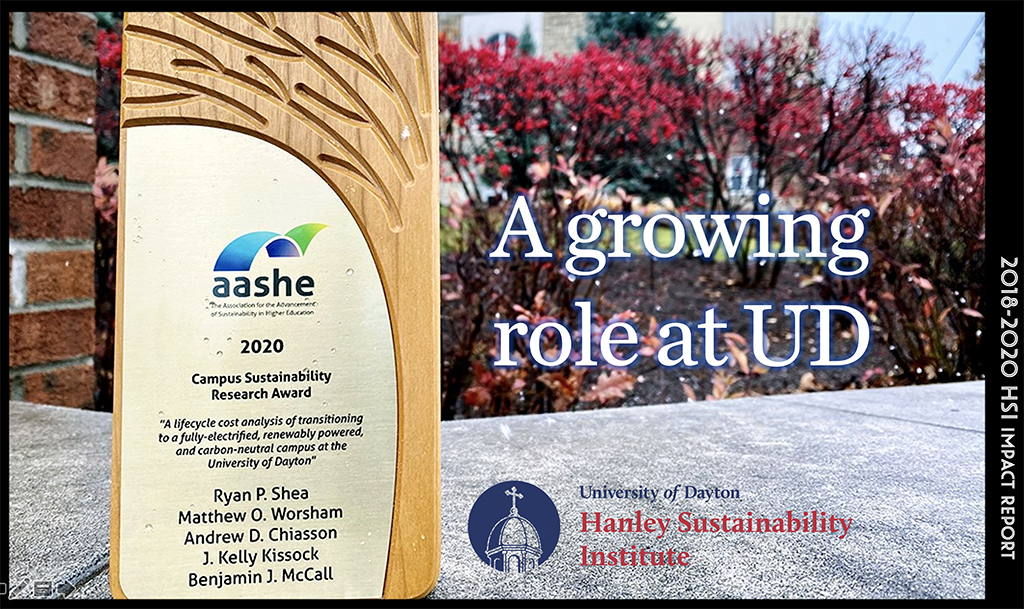Hanley Sustainability Institute

Shea’s research award led students’ many contributions to Hanley Sustainability Institute’s 2018-2020 Impact Report
By Mark Gokavi
Ryan Shea enrolled at the University of Dayton in 2012 and earned degrees in 2016 and 2018, but his impact on UD’s sustainability efforts continued to be felt in 2020.
Shea was the lead author of a research paper on the cost of carbon neutrality at UD that won an Association for the Advancement of Sustainability in Higher Education (AASHE) 2020 Sustainability Research Award.
“Limiting global warming to 1.5C° (2.7F°) to prevent the worst effects of climate change absolutely necessitates an immediate transition from a fossil fuel-based energy system to one that’s renewably powered,” Shea said. “Our research showed that at the University of Dayton, and likely other universities, this imperative is not only possible but cost-effective.”
Shea, who graduated with a mechanical engineering major and sustainability minor before adding a master’s degree in renewable and clean energy, was an HSI graduate assistant, a Fulbright Program researcher, a solar ambassador at RE-volv and a Sustainability Club member. Shea is now a senior associate at Rocky Mountain Institute in Boulder, Colorado.
The AASHE honor was just one of many highlights in the Hanley Sustainability Institute’s 2018-2020 Impact Report, “A growing role at UD,” that chronicles collaborative successes by HSI, facilities management, and many other faculty, staff and students.
The 46-page impact report released in the first quarter of 2021 includes dozens of student-led projects and initiatives that built upon the ideals set forth when George ’77 and Amanda Hanley’s gift of $12.5 million established HSI in 2014.
Working with UD faculty and staff, students were heavily involved in nearly every aspect of the continued growth of both HSI and the sustainability program. Key student contributions included:
- Former HSI student leaders Grant Karda, Lauren Murray and other students helped with the design of the sustainability program’s BS and BA degrees.
- Murray and others worked with HSI and facilities management staff on the Curran Place solar array and pollinator prairie, now known as the solar prairie.
- Students joined several organizations in organizing and participating in the 2019 global climate strike.
- Students collected data and helped present information to AASHE which led to a gold rating in the Sustainability, Tracking and Rating System (STARS) rankings, the top score among Midwestern universities.
- Facilities management and HSI graduate assistant Jack Rees worked on temperature setbacks that saved the university money in energy costs when the pandemic struck.
- The student leaders’ education team taught fellow students about sustainability and launched an after-school sustainability program at the Dakota Center in Dayton’s McFarlane neighborhood.
- The student leaders’ energy team helped run the Energy GPA program for houses in the student neighborhood and a mini-course covering how energy is consumed in buildings.
- The student leaders’ food and growing team helped plant and harvest the urban garden at Old River Park and worked with facilities management to plant native species on campus.
- The student leaders’ zero waste team expanded the composting program and supported large campus occasions with a goal of achieving zero waste.
- Former HSI graduate assistants Lauren Wolford and Tess Isemann piloted an office ecology project.
- Wolford and fellow HSI graduate assistant Meg Maloney worked for months on the resilience assessment of UD and the city of Dayton as part of the university’s commitment to Second Nature.
Shea’s paper was written with HSI Executive Director Ben McCall, energy efficiency and renewable energy manager Matthew Worsham, engineering professor Andrew Chiasson and former UD engineering professor Kelly Kissock.
“This recognition of our work shows how powerful it can be when graduate students, faculty and the facilities management team up to tackle sustainability challenges,” McCall said.
During the 2018-2020 timeframe, HSI moved into new offices, saw the staff and sustainability faculty expand and offer students more opportunities.
“The past three years have been a remarkable period of expansion for the Hanley Sustainability Institute,” McCall said. “I’m pleased to share this summary of HSI’s impact during this period.”
For more sustainability news and information, visit HSI’s news blog, the Hanley Sustainability Institute website and the sustainability program website. To sign up for HSI’s Sustainability Spotlight newsletter, register here.
